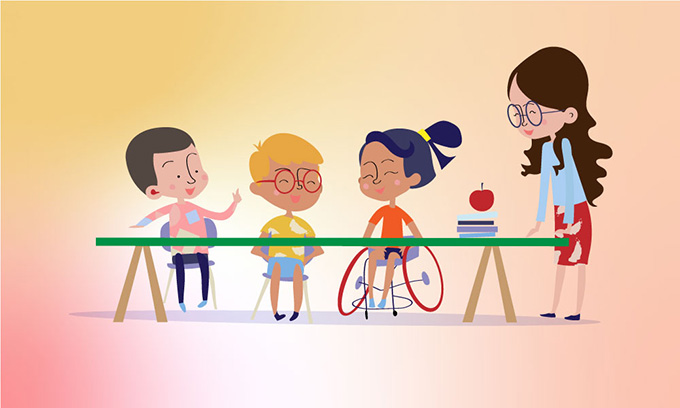
One of the controversies that the new draft Education Law ( LOMLOE ) has raised derives from its fourth additional provision regarding the evolution of the schooling of students with special educational needs .
In the 2018-2019 academic year, there were 37,136 students enrolled in special education centers in Spain , 0.45% of the school population –8.17 million students–, 59.6% in 191 public schools and the 40% remaining in 280 subsidized centers. Ratios don’t help them get the care they need.
The debate generated points to the situation of special education centers vis-à-vis inclusive education. Specifically, the law includes the following:
The Government, in collaboration with the educational administrations, will develop a plan so that, within ten years, in accordance with article 24.2.e) of the United Nations Convention on the Rights of Persons with Disabilities and in compliance with the fourth Sustainable Development Goal of the 2030 Agenda, ordinary centers have the necessary resources to be able to serve students with disabilities in the best conditions. The educational administrations will continue to provide the necessary support to special education centers so that these, in addition to educating the students who require highly specialized attention, play the role of reference and support centers for ordinary centers.
The Government has already published a document in which it is clear that the special education centers will not close. LOMLOE will facilitate families’ freedom of choice for the most inclusive regime that meets the educational needs of their sons and daughters. However, it is important to understand that it is a framework law that each autonomous community will have to reinforce with policies that favor the inclusion of this type of student body – greater financial and human resources.
Inclusion is a right and we must rethink policies, cultures and educational practices, tackling this challenge from distributed leadership, counting on all the parties involved (families, students, professionals and other community agents) and creating true alliances so that this type of education is really a right for all people.
As researchers and teachers – we have been working on this issue for more than a decade – we have learned that collaborative and participatory work is essential to develop more inclusive environments.
Ordinary educational centers need resources
It is necessary that ordinary educational centers have more resources, and that these are diverse and plural is positive and represents progress, but it is insufficient if this is not linked to an inclusive culture and practices.
If the centers are to be diverse, and that diversity is understood as wealth, it is necessary that the different needs of all students be met and that a quality education be generated and worked on where all students are taken into account and their right to education is respected. Likewise, the importance of creating safe spaces for everyone is fundamental.
Taking into account the key role of the school for the creation of networks and as a meeting space where friendship develops, it is important to take care of this aspect, so that including also means taking care of all the students and that they do not feel marginalized or separated by their condition, whatever.
Discrimination situations
We know realities where mothers and fathers with the best intention have taken their children to special education schools because they have felt discriminated against in the ordinary school (because the ordinary school in some cases is not prepared to respond to their needs), and this should not happen.
The law has to advance these policies, but it is insufficient if the necessary mechanisms are not put in place so that diversity in educational centers is not a utopia.
How do we ensure that schools are inclusive and responsive to all students without any form of discrimination? It is necessary to be aware of this and to work in the centers for and to promote it and the law should also develop it by providing more resources and strategies for action and evaluation methods.
We can analyze the lessons learned in other countries to believe that a quality educational response is possible and “move from a dual model of schooling to a single model, close to the ambition of full inclusion .”
There is still way to go
That is why we believe that, although at the theoretical level we are in inclusive postulates, the realities of our educational environments are far from this postulate in many cases and there is still a long way to go.
We must change educational contexts based on the needs of all students, eliminating barriers to create schools where all people are welcome and are empowered to the maximum of their abilities.
Let us develop ordinary schools, in which diversity is a value, counting on the necessary resources and walking alongside the knowledge and experience of professionals who have been responding to students with disabilities for many years.
We owe our sons and daughters a world in which situations of exclusion remain in history. In short, we are in favor of the “Inclusive Education. Wanting it is creating it ” and we need to move towards transforming and improving the educational system.
Author Bios: Naiara Berasategui Sancho is Professor in the Department of Didactics and School Organization and Leire Darretxe Urrutxi is with Educational and Social Inclusion both at the University of the Basque Country / Euskal Herriko Unibertsitatea
